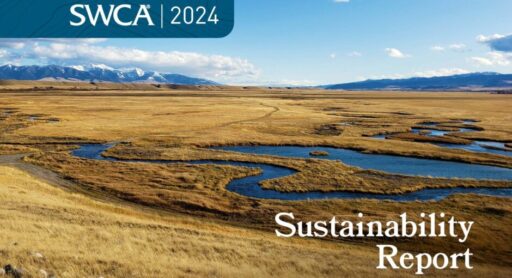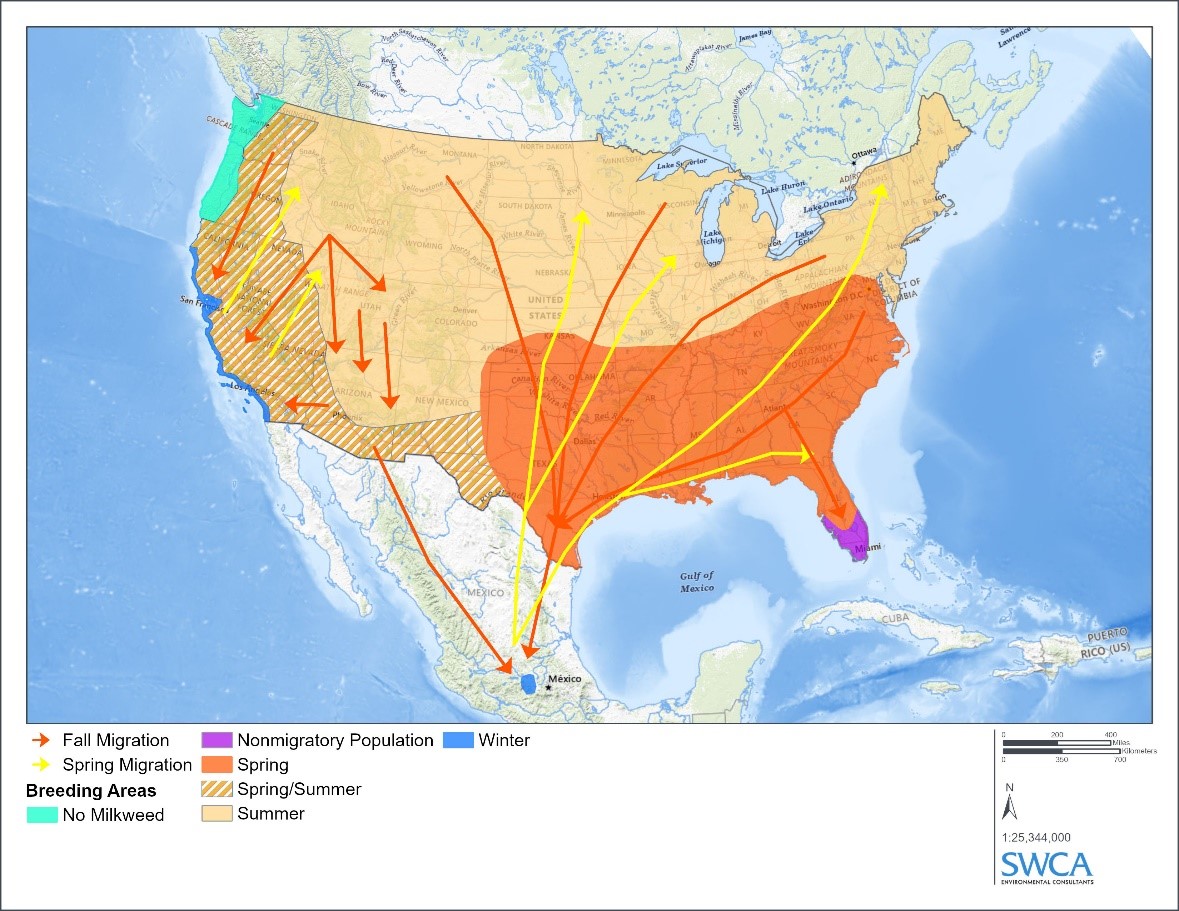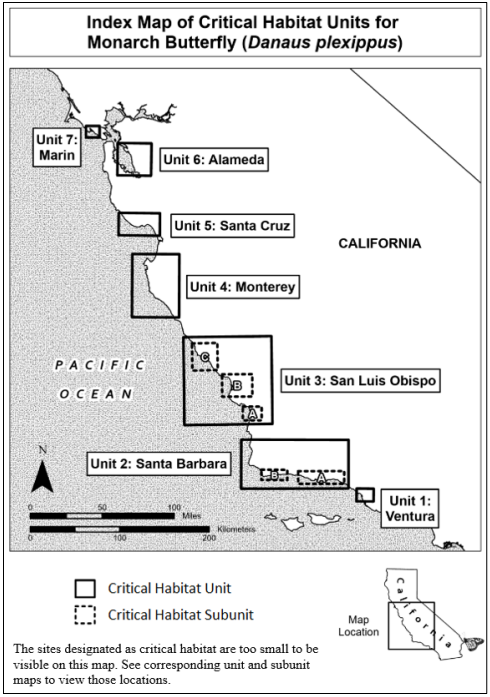2025
Comparably’s Best Company Outlook
* Providing engineering services in these locations through SWCA Environmental Consulting & Engineering, Inc., an affiliate of SWCA.

From the experts we hire, to the clients we partner with, our greatest opportunity for success lies in our ability to bring the best team together for every project.
That’s why:

At SWCA, sustainability means balancing humanity’s social, economic, and environmental needs to provide a healthy planet for future generations.
SWCA employs smart, talented, problem-solvers dedicated to our purpose of preserving natural and cultural resources for tomorrow while enabling projects that benefit people today.

At SWCA, you’re not just an employee. You’re an owner. Everyone you work with has a stake in your success, so your hard work pays off – for the clients, for the company, and for your retirement goals.
U.S. Fish and Wildlife Service Proposes Listing of the Monarch Butterfly Under the ESA
The monarch butterfly (Danaus plexippus) is an iconic butterfly, well-known around the world due to its striking physical appearance, global distribution, and long-distance migration patterns.
Amanda Glen is SWCA’s natural resources technical director for biological services and provides strategic guidance on permitting and compliance for matters involving protected wildlife, plants, and habitats. Currently managing a national practice, she has more than 25 years of consulting experience with an emphasis on the Endangered Species Act (ESA) and how compliance with the ESA influences other regulatory programs. Her wealth of experience pertaining to endangered species issues includes research, permitting, consultations, status reviews, and conservation planning. Her experience includes negotiating compliance solutions for critically imperiled species facing potential determinations of jeopardy or adverse modification of designated critical habitats. She has led efforts to delist species no longer requiring the protections of the ESA when supported by sound science, and has been involved in voluntary conservation planning to help preclude the need to list species. Amanda frequently presents at regional and national conferences on matters related to the ESA, including new listings, regulatory and policy changes, and trends in compliance strategies.

Eleanor Gladding is a senior biologist and project manager in SWCA’s Tucson office. As a herpetologist and ecologist, her areas of expertise include endangered species habitat studies, revegetation planning, species-specific surveys, noxious weed issues, and wildlife-habitat relationships. She is adept at identifying plants and animals, their habitat, and signs of presence. She is also skilled at writing technical and non-technical reports and conducting the extensive literature research that accompanies writing at the professional level. Her duties as a biologist include study design, field studies and special-status species surveys, and report writing and editing.

Kely Wabnitz is a biologist and principal project management team lead specializing in complex permitting issues, is an Endangered Species Act (ESA) regulatory practitioner, and has worked throughout the country, specifically the Midwest and Great Plains, for more than two decades. Kely has outstanding experience in ESA compliance and National Environmental Policy Act (NEPA) review documentation, a thorough knowledge of the biology and conservation of listed species in the Midwest, and extensive experience assisting clients with regulatory issues throughout the country. She routinely manages challenging compliance and permitting issues related to large-scale, regional, and multistate development projects. Kely has robust experience navigating related discussions, coordination, and consultations with the U.S. Fish and Wildlife Service (USFWS), specifically in Regions 2, 3, 5, and 6, and with state public siting commissions and natural resources agencies. She has worked with clients throughout the United States and has supported the successful acquisition of state and local siting permits through development of statutorily complete applications, preparation of written testimony requiring subject matter expertise, and support during public hearings.

Sharif Durzi is an experienced field and research biologist with over 9 years of experience with for-profit, non-profit, and academic organizations. He has a focus in entomology, threatened and endangered species, animal behavior, and invasive species eradication. He has conducted fieldwork primarily focused in coastal southern California, working with and managing crews of biological field technicians in remote settings with hazardous conditions. Sharif has experience with Endangered Species Act (ESA) and California Endangered Species Act (CESA) compliance on federal lands, and he has extensive experience conducting surveys as a field crew leader in coastal southern California vegetative communities for the United States Navy.

As a Project Biologist for SWCA, Brittany works primarily on projects that require Endangered Species Act (ESA) compliance as a Subject Matter Expert, Project Manager, biologist, author, and technical/field staff. This includes writing and serving as Subject Matter Expert for Biological Assessments (BAs) for ESA section 7 ESA compliance, Habitat Conservation Plans (HCPs) for application of section 10 ESA permits, habitat assessments, threatened and endangered species reviews, and critical issues analysis reports. Brittany manages projects for renewable energy and oil and gas clients in which she obtains necessary permits for ESA, Clean Water Act, and other code compliance; designs and implements surveys for threatened, endangered, proposed, and candidate species; and coordinates routine constraints analyses.
Brittany serves as both a Biology Champion and Quality Champion for SWCA in which her primary role is to act as leader and mentor to staff company-wide for conservation of at-risk species and for improving and standardizing the high quality products that SWCA delivers to clients. Brittany possesses a Letter of Authorization from the U.S. Fish and Wildlife Service (USFWS) to conduct surveys for the lesser prairie-chicken and a Scientific Research Permit from Texas Parks and Wildlife (TPWD) to handle and relocate Texas’ native wildlife. she also performs field surveys for monarch butterfly and under supervision for Eurycea salamanders; performs acoustic analysis for bat species of the eastern and western U.S.; and is proficient in vegetation surveys, avian surveys, and other threatened and endangered species surveys. As a member of The Wildlife Society, Brittany holds certification as an Associate Wildlife Biologist®, and attends and presents at annual member conferences.






The monarch butterfly (Danaus plexippus) is an iconic butterfly, well-known around the world due to its striking physical appearance, global distribution, and long-distance migration patterns. Within the continental United States, monarchs occur in at least three populations, including the two migratory populations (western population, eastern population) with the Rocky Mountains acting as the general divider, and a non-migratory population in south Florida.

On December 12, 2024, the U.S. Fish and Wildlife Service (USFWS) proposed listing the monarch butterfly under the Endangered Species Act (ESA) as a threatened species with special rules for “take” exemptions. The proposed exemptions include the following:
USFWS also proposed to designate critical habitat on the western populations’ wintering grounds in southern California, totaling approximately 4,395 acres across seven counties.

USFWS identified the major threats to the monarch as the availability, distribution, and quality of milkweed and nectar resources; insecticide exposure; and climate change.
The monarch butterfly occurs in a wide range of habitats, including both natural (e.g., grasslands, shrublands) and urban landscapes, but requires the presence of milkweed and flowers to complete its natural life cycle. While the species is not found in forested landscapes within their migratory range, the monarch requires stands of trees to form dense clusters within the species’ overwintering range (southern California and Mexico).
It will be important to assess if any of your projects would modify monarch butterfly habitat. Although species proposed for listing are not protected by the ESA, federal agencies must confer with the USFWS if their actions would likely jeopardize the species’ continued existence or adversely modify proposed critical habitat. If the monarch butterfly is listed as threatened under the ESA, projects that impact monarch butterflies will need to consider whether a take permit is needed.
A public comment period is in place until March 12, 2025, for this proposed listing. All comments may be submitted either electronically through the Federal eRulemaking Portal or by mail. Two virtual public information meetings (registration required) will be held on January 14, 2025, from 6:00 p.m. to 8:00 p.m. ET and again on January 15, 2025, from 8:00 p.m. to 10:30 p.m. ET. Details on the proposed listing, comment submittal, and public meeting information are available in the Federal Register under docket number FWS-R3-ES-2024-0137.
Let us help you craft and submit your comments on the proposed rule and critical habitat designation for the monarch butterfly. Project proponents may want to submit comments if the species or critical habitats may occur within their project area or may be affected by routine project activities, thus affecting project timelines and key business decisions. Our experienced team is ready to assist with evaluating the sufficiency of data supporting the decision and analyzing the areas considered but excluded as critical habitat and the rationale behind those decisions.
We can also help you review the timeline for the finalization of the listing decision as it relates to your project timelines, and understand how the listing may affect your ongoing or future activities.